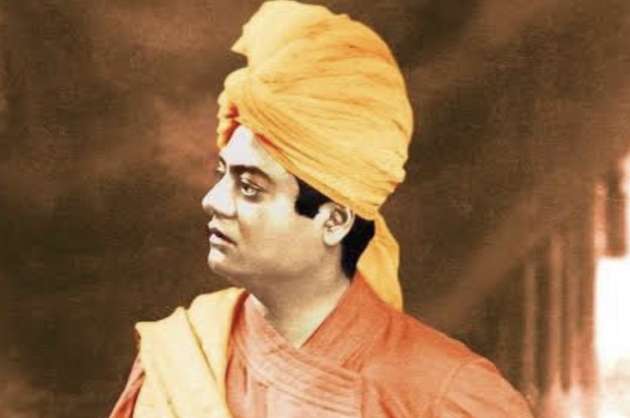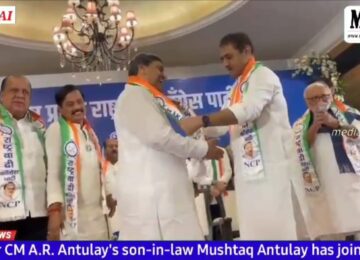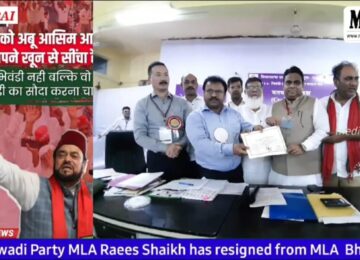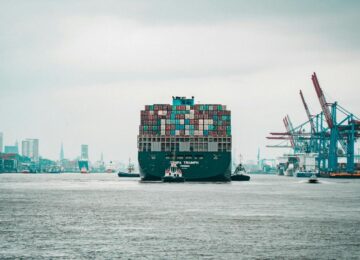-By Anupama Nair
Mumbai, April 8
Swami Vivekananda (12 January 1863 — 4 July 1902), born as Narendranath Datta or Naren, was one of the greatest sons of Bharat Maa. He is one of the persons who has inspired me in every aspect of my life. Just reading his book “My India, Eternal India” on a train journey changed my views of my great country. In the words of a disciple of Swamiji, Sister Christine “Our love for India came to birth, I think, when we first heard him (Swami Vivekananda) say the word, "India", in that marvelous voice of his. It seems incredible that so much could have been put into one small word of five letters. There was love, passion, pride, longing, adoration, tragedy, chivalry, and again love. Whole volumes could not have produced such a feeling in others. It had the magic power of creating love in those who heard it.” The result was me; a big fan of the Western life and philosophy began to look towards my own country of birth now with a change. It is not possible to write about such a great person in a single article, so it will be in two parts.
Swamiji was the chief disciple of the 19th-century saint Sri Ramakrishna Paramahamsa. He was a key figure in the introduction of the Indian philosophies of Vedanta and Yoga to the Western world, and is credited with raising inter-faith awareness, bringing Hinduism to the status of a major world religion during the late 19th century. He was a major force in the contemporary Hindu Reform Movements in India, and contributed to the concept of nationalism in Colonial India. Vivekananda founded the Ramakrishna Matt and the Ramakrishna Mission. He is perhaps best known for his speech which began with the words "Sisters and brothers of America, in which he introduced Hinduism at the Parliament of World Religions in Chicago in 1893.
I learnt about Swami Vivekananda when I was associated with Ramakrishna Mission from childhood and I was lucky to work as an honorary teacher in Ramakrishna Mission School. Staying in Trivandrum in childhood, Kanyakumari was my favorite place to visit. The Vivekananda Rock Memorial inspired me to learn about his life and read his books. You read any of his books, love for this great country fills you. It is said “If Vivekananda hadn’t been a sanyasi, he would have fought against colonial rule”. His love for our mother land was immense and can be seen his books and his speeches.
Let me tell you about his early life. Naren was the son of Bhuvaneshwari Devi and Vishwanath Datta. Naren was born in Calcutta, the then capital of British India. Delhi became the capital of British India in 1911 after the proclamation of the King George V. Naren was interested in spirituality as a young boy and used to meditate before the images of deities such as Shiva, Ram, Sita and Hanuman. As a boy he was very mischievous and his mother Bhuveneshwari Devi used to scold him and said “I prayed to Bhootnath (Bhagvan Shiva) for a son and he sent me one of his Bhoot (demons)".
In 1871, at the age of eight, Naren was enrolled at Ishwar Chander Vidyasagar Metropolitan Institution, and studied there till his family, migrated to Raipur in 1877. In 1879, after his family's return to Calcutta, he was the only student to receive first-division marks in the Presidency College entrance examination. He was an avid reader in a wide range of subjects, including philosophy, art and literature, and history. He was also interested in Hindu philosophy like Vedas, Upanishads, Gita, Ramayana, Mahabharata and Puranas. Naren was interested in classical music, and sports. He used to do Yoga and exercise to keep himself fit. Later he studied Western Philosophy and European History at Scottish Church College. Along with studying the works of Western philosophers, he also learned Sanskrit scriptures and Bengali Literature.
William Hastie (former principal of Christian college, from where he graduated) wrote “Narendra is really a genius. I have travelled far and wide but I have never come across a lad of his talents and possibilities, even in German universities, among philosophical students. He is bound to make his mark in life", which he did as we all know. Once he had an argument with a Swedish national where he gave reference to some details on Swedish history that the Swede originally disagreed with but later conceded.
In 1880, Narendra joined Kesab Chandra Sen’s “Nava Vidhan” which was established by Sen after meeting Sri Ramakrishna. Narendra became a member of the Sadhan Brahmo Samaj in his twenties, which was a breakaway faction of the Brahmo Sama (founded by Ram Mohan Roy in in 1828) led by Sen and Debendranath Tagore (father of Rabindranath Tagore). From 1881 to 1884, he was also active in Sen's Band of Hope, which tried to discourage youths from bad habits like smoking and drinking.
It is said he asked several prominent Calcutta residents if they had come "face- to-face with God", but none of their answers gave him satisfaction. At this time, Narendra met Debendranath Tagore, and asked if he had seen God. Instead of answering his question, Tagore said "My boy, you have a Yogi’s eyes." According to Banhatti, a historian it was Sri Ramakrishna who really answered Narendra's question, by saying "Yes, I see Him as I see you, only in an infinitely intense sense." It was also due to Sen that he met his Guru and idol Sri Ramakrishna.
In 1881, Narendra met Ramakrishna, who became his Guru after his own father Vishwanath Datta died in 1884. Narendra's first introduction to Ramakrishna occurred in a literature class at Scottish Church College when he heard Professor William Hastie lecturing on William Wordsworth’s poem, “The Excursion”. While explaining the word "trance" in the poem, Hastie suggested that his students visit Sri Ramakrishna of Dakshineshwar, to understand the true meaning of trance. This inspired Narendra to visit Sri Ramakrishna.
At this time, Narendra was preparing for his upcoming F.A. (Formative Assessment) examination, when Ram Chandra Dutta accompanied him to Surendra Nath Mitra's house
, where Sri Ramakrishna was invited to deliver a lecture. It is believed that at this meeting, Sri Ramakrishna asked young Narendra to sing and impressed by his singing talent, he asked Narendra to come to Dakshineshwar.
In late 1881 or early 1882, Narendra went to Dakshineswar with two friends and met Sri Ramakrishna. This meeting proved to be a turning point in the life of Naren. Although, he did not initially accept Ramakrishna as his teacher and rebelled against his ideas, he was attracted by his personality and began to frequently visit him at Dakshineswar. He initially saw Sri Ramakrishna's ecstasies and visions as "mere figments of imagination" and "hallucinations". As a member of Brahmo Samaj, he opposed idol worship, polytheism and Ramakrishna's worship of Devi Kali. He even rejected the Advaita Vedanta of "identity with the absolute", and often ridiculed the idea. Narendra even tested Sri Ramakrishna, who faced his arguments patiently, "Try to see the truth from all angles", he replied to his shishya
Narendra's father's sudden death in 1884 left the family bankrupt, creditors began demanding the repayment of loans, and relatives threatened to evict the family from their ancestral home. Narendra, once a son of a well-to-do family, became one of the poorest students in his college. He unsuccessfully tried to find work and became an atheist. He found solace in Sri Ramakrishna and his visits to Dakshineswar became more frequent
One day, Narendra requested Sri Ramakrishna to pray to Devi Kali for their family's financial welfare. Ramakrishna advised him to go to the temple himself and pray. Following Sri Ramakrishna's suggestion, he went to the temple thrice, but failed to pray for any kind of worldly necessities and ultimately prayed for true knowledge and devotion from the Devi. Narendra gradually grew ready to renounce everything for the sake of God realization, and accepted Sri Ramakrishna as his Guru.
In 1885, Sri Ramakrishna developed throat cancer, and was transferred to Calcutta and later to a garden house in Cossipore. Narendra and Sri Ramakrishna's other disciples took care of him during his last days, and Narendra's spiritual education continued even though his Guru was in his death bed. At Cossipore, he experienced Nirvikalpa Samadhi (highest stage of Samadhi).
Narendra and several other disciples received ochre robes from Sri Ramakrishna, forming his first monastic order. He was taught that “manav seva” was the most effective worship of God. Sri Ramakrishna asked him to care for the other disciples, and in turn asked them to see Narendra as their Guru now. Sri Ramakrishna died in the early-morning hours of 16 August 1886 in Cossipore. Many disciples abandoned the sanyasi way of life and adopted grahasthashram. Narendra decided to convert a dilapidated house at Baranagar into a new matt for the remaining disciples. Rent for the Baranagar Matt was low, raised by "holy begging". The matt became the first building of the Ramakrishna Matt, the monastery of the monastic order of Sri Ramakrishna. Narendra and other disciples used to spend many hours in practicing meditation, and religious austerities every day.
On the Christmas Eve of 1886, Narendra and eight other disciples took formal monastic vows. They decided to live their lives as their master Sri Ramakrishna lived. In 1888, Narendra left the monastery as a Parivrâjaka— the Hindu religious life of a wandering monk, "without fixed abode, without ties, independent and strangers wherever they go". His sole possessions were a kamandalu (water pot), staff and his two favorite books: The Bhagvad Gita and the Imitation of Christ written by Thomas Kempis. Narendra travelled extensively in India for five years, visiting centers of learning and familiarizing himself with diverse religious traditions and social patterns. He developed sympathy for the suffering and poverty of the people, and resolved to uplift the nation. Living primarily on bhiksha (alms), Narendra travelled on foot and by railway (with tickets bought by admirers). During his travels he met, and stayed with Indians from all religions and walks of life –scholars, dewans, rajas and government officials. Narendra left Bombay for Chicago on 31 May 1893 with the name "Vivekananda", which was suggested by Maharaj Ajit Singh of Khetri, which means "the bliss of discerning wisdom," from Sanskrit viveka and Ananda.
Vivekananda started his journey to the West on 31 May 1893, and visited several cities in Japan, China and Canada en-route to the United States, reaching Chicago on 30 July 1893, where the "Parliament of Religions" took place in September 1893. The Congress was an initiative of the Sweden-Borgian layman, and judge of the Illinois Supreme Court, Charles Bonney to gather all the religions of the world, and show "the substantial unity of many religions in the good deeds of the religious life." It was one of the more than 200 adjunct gatherings and congresses of the Chicago's World's Fair, and was "an avant-garde intellectual manifestation of cultic milieus, East and West," with the Brahmo Samaj and the Theosophical Society being invited as representative of Hinduism
Swamiji wanted to join the Parliament, but was disappointed to learn that no one without credentials from a bonafide organization would be accepted as a delegate. He contacted Professor John Wright of Harvard University, who invited him to speak at Harvard. Vivekananda submitted an application, "introducing himself as a monk “of the oldest order of sanyasis” founded by Adi Shankara, supported by the Brahmo Samaj representative Pratap Chandra Mozzambar, who was also a member of the Parliament's selection committee, "classifying the Swami as a representative of the Hindu monastic order." Hearing Vivekananda speak, Harvard psychology professor William James said, "that man is simply a wonder for oratorical power. He is an honor to humanity."
… To be continued
(Dedicated to Ramakrishna Mission –Trivandrum, Vivekananda Ashram – Kanyakumari, Ramakrishna Mission School – Jamshedpur, and Belur Matt – Calcutta)





























Great job
Vande Mataram Anu
Great man
Swamiji you are great.
Great man
Great India eternal India
Great man
Well done Anupama and Media Eye
Please publish more such articles before Guru Poornima
Great patriot
Great person
I admire him a lot.
I admire him so much.
I admire him so much
Great souls.
I admire him.
Great person
Great man.
I admire him.
I admire him so much.
Great souls.
Great souls.
Great man.
The Monk Who Changed the Perception of Bharat to the West
The Monk Who Changed the Perception of Bharat to the West
The Monk Who Changed the Perception of Bharat to the World
Great saint of India.
Great saint of India.
Great saint of India.
Nice article.
Great article
Great article
Great son of India.
Great son of India.
great man
Swamiji you are an inspiration.
Swamiji you are an inspiration.